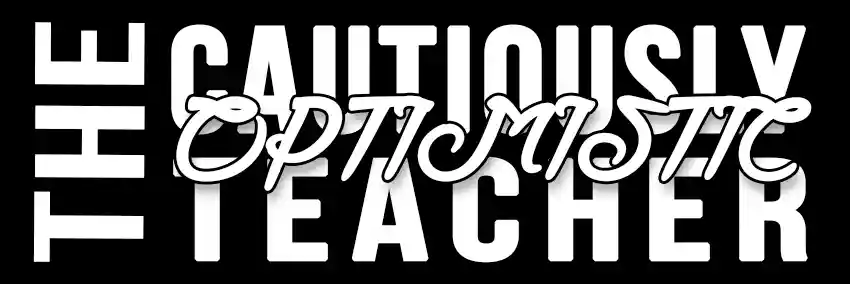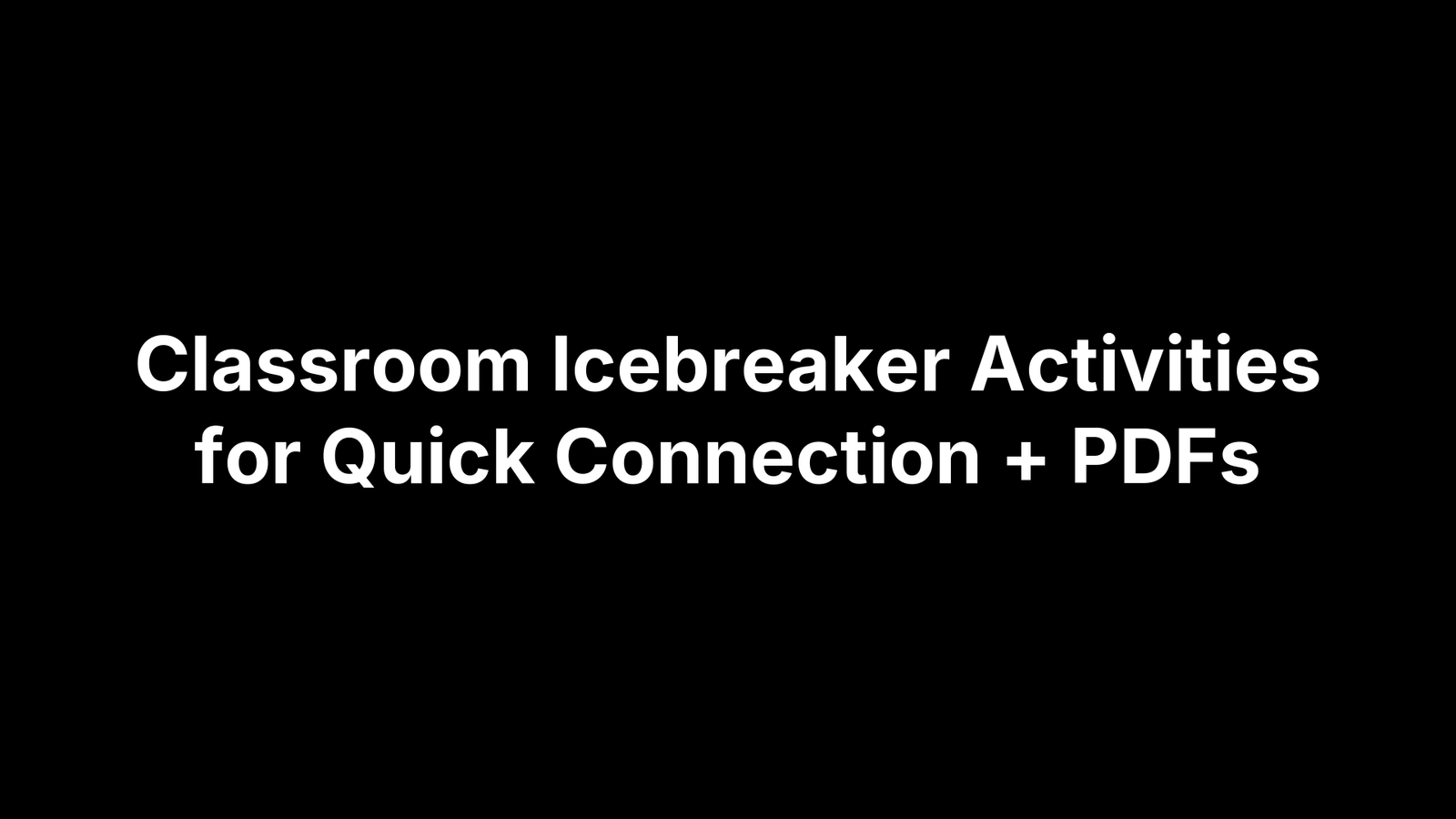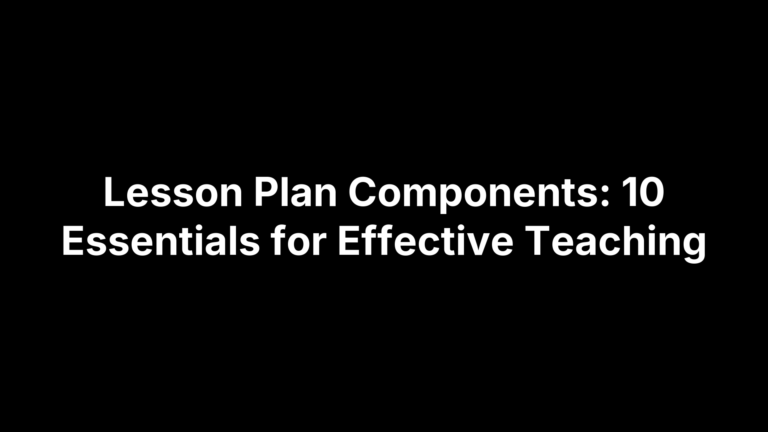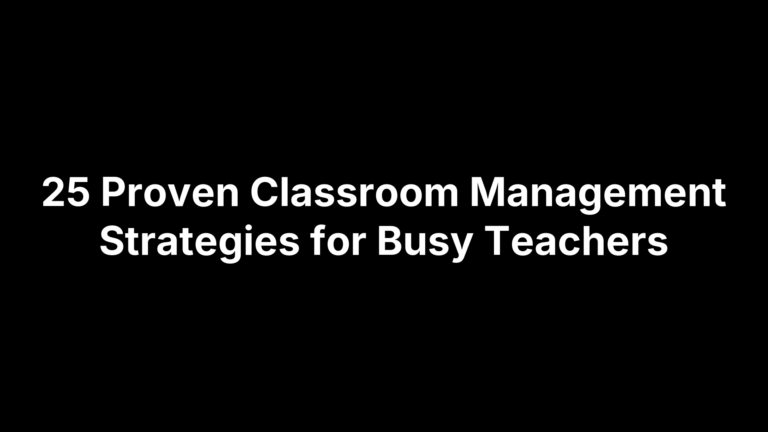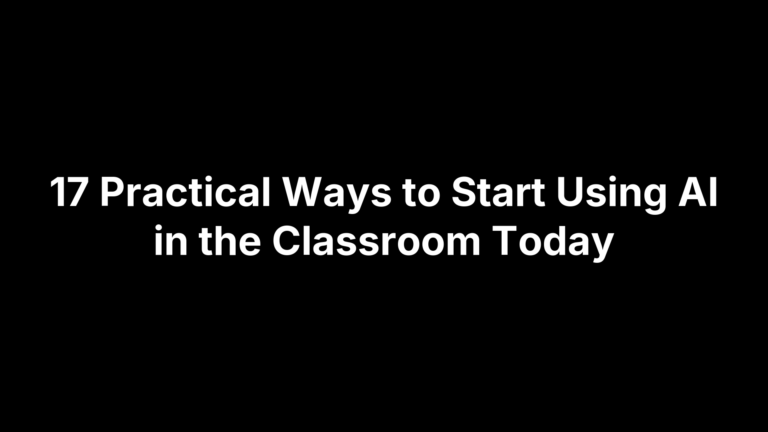Classroom Icebreaker Activities for Quick Connection
Those first five minutes can make or break the tone of your class. You need classroom icebreaker activities that are quick, low-risk, and genuinely engaging—without hours of prep or awkward silence. Maybe your group is a mix of shy and talkative students, maybe you’re juggling large classes, limited space, or a hybrid setup. You want activities that build trust fast, fit different energy levels, and come with ready-to-print prompts so you can hit the ground running.
This guide delivers 21 proven icebreakers for instant connection—each with an at-a-glance summary, step-by-step directions, UDL-friendly adaptations, and a printable PDF you can use today. You’ll also get The Cautiously Optimistic Teacher Icebreaker Starter Kit plus AI helpers to customize questions in seconds for any age or subject. Whether you teach in person or online, you’ll find simple, flexible choices that work right away. Let’s get you set up for a strong start.
1. The Cautiously Optimistic Teacher icebreaker starter kit
Short on time? This starter kit gives you free PDFs and AI helpers to launch classroom icebreaker activities in minutes. It’s your plug-and-play baseline for any group and schedule.
At-a-glance
Runs 5–10 minutes, any class size. Works in-person, hybrid, or online.
What it is
Prompt banks, mini-scripts, and timing cues. Plus our Question Generator, Worksheet Maker, and Differentiated Instruction Helper.
How to run it
Choose an activity and generate prompts. Print or project; press start and go.
Adaptations and UDL tips
Offer choices: speak, write, draw, or chat. Pre-plan options for mobility, sensory, and language.
Printable PDF
Grab the quick-start and blank templates below. Reuse weekly; just swap prompt sets.
2. Classmate bingo
A classic mixer that gets everyone moving and talking with purpose.
At-a-glance
Runs 5–10 minutes; scales to any class size; best in-person.
What it is
Students get bingo cards with prompts and circulate to find peers who match, collecting initials to complete a row, column, or blackout.
How to run it
Model one prompt and follow-up question, set a clear time limit, allow one name per square, and celebrate the first bingo; continue for blackout if time.
Adaptations and UDL tips
Provide sentence starters, visual icons, or simplified language; allow seated swaps or assigned partners; permit stickers or verbal confirmations for fine-motor or language needs.
Printable PDF
Use the ready-to-print prompt card plus a blank template to customize by unit, grade, or theme.
3. This or that (four corners)
A quick movement-based vote that warms up talk without putting anyone on the spot. In “This or that,” students choose a side (or four corners) for a fast yes/no, true/false, or would‑you‑rather prompt—great for checking background knowledge and jump-starting discussion. It’s one of those classroom icebreaker activities you can run anytime to reset energy.
At-a-glance
3–6 minutes; space to move; in-person or virtual.
What it is
Students pick a side/corner to show their answer or preference.
How to run it
Post options; ask; move; 15‑second pair share; sample two reasons; repeat 3–5 rounds.
Adaptations and UDL tips
Offer hand signals, color cards, or chat; add icons and sentence stems; allow a “pass” zone.
Printable PDF
Corner signs, starter prompts, and a blank template ready to customize.
4. Blobs and lines (find your match)
A quick, movement-based sorter—one of those classroom icebreaker activities that uncovers instant connections as students form lines or “blobs” from simple prompts.
At-a-glance
Fast; any class size.
What it is
Lines = ordered sequence; blobs = clusters by a shared trait (birth month, clothing color).
How to run it
Announce a prompt, students organize, briefly debrief choices, then switch prompts and repeat.
Adaptations and UDL tips
Use cards or chat instead of movement; add icons; include a “pass” zone; offer seated partners or fixed stations.
Printable PDF
Prompt list, room signs, and a blank template to customize.
5. Two truths and a lie
A low‑risk classic among classroom icebreaker activities that gets students talking fast and builds trust. Peers probe and try to spot the lie—great for listening, questioning, and quick laughs.
At-a-glance
4–6 minutes; any modality.
What it is
Share 3 statements; 1 lie.
How to run it
Model; write; share; ask 1–2 follow‑ups; reveal.
Adaptations and UDL tips
Chat/cards, stems, pass option; pairs.
Printable PDF
Slips, stems, blank template.
6. Find someone who
A quick mingle where students find peers who match light prompts. Low-risk and energizing, it gets everyone talking with a clear purpose.
At-a-glance
5–7 minutes; any size; in-person or online.
What it is
A prompt grid; students meet matches and record names.
How to run it
Model, set timer, one name per peer, circulate, brief debrief.
Adaptations and UDL tips
Icons, stems, pass; seated swaps; chat/shared doc online.
Printable PDF
Ready-made grids for this classroom icebreaker activity plus a blank template.
7. Speed meeting carousel
If you want maximum connections in minimal time, run a Speed meeting carousel. Students rotate through rapid 60–90 second chats with new partners, using simple prompts that keep energy high and stakes low. It mirrors the “speed dating” format seen in classroom icebreaker activities and works beautifully on day one or to launch a new unit.
At-a-glance
6–10 minutes; any size; in-person lines/circles or online with partner shuffles.
What it is
Paired mini-conversations with timed rotations and fresh prompts each round.
How to run it
Form two concentric circles or two facing lines. Ask a prompt; talk 60–90 seconds; rotate the outer line one step; repeat 4–6 rounds; quick whole‑class share.
Adaptations and UDL tips
Provide sentence stems, visual prompts, and a pass option. Run seated or “stay‑put” partners for mobility needs; use chat or note cards for quieter speakers; captions and posted prompts online.
Printable PDF
Prompt bank, rotation map, and a one‑page timer script ready to print.
8. Beach ball toss Q&A
One of the simplest classroom icebreaker activities to spark instant talk: write short prompts on a beach ball, toss it around, and whoever catches answers the question nearest their left thumb. It’s playful, low‑risk, and scales to any group.
At-a-glance
Quick (about 5 minutes); any class size; best in-person.
What it is
A question‑covered ball that prompts spontaneous, bite‑size Q&A as students toss and catch.
How to run it
Prep the ball with prompts; form a circle; toss; call “stop”; the catcher answers the prompt closest to their left thumb; allow one brief follow‑up; repeat.
Adaptations and UDL tips
Use a soft foam ball; add icons and sentence stems; allow a pass; swap the toss for table cards or an on‑screen randomizer in online classes.
Printable PDF
Ready‑to‑print prompt banks (plus category sets) and a blank layout to tape onto your ball.
9. Time bomb name game
A fast-paced name game for focus and fun. Students have seconds to call a classmate’s name and pass the “time bomb.”
At-a-glance
3–5 minutes; circle; in-person.
What it is
Pass-the-ball name game; two‑second limit.
How to run it
Toss; catcher says a new name in 2 seconds and throws; misses out.
Adaptations and UDL tips
Use 3–4 seconds, hand‑off, name tents, or non‑elimination.
Printable PDF
Rules, timer cues, variations.
10. Candy colors Q&A (Skittles/M&Ms)
A sweet classroom icebreaker: candy colors = questions. Students pick a color and a prompt—quick, playful, and low‑risk.
At-a-glance
3–5 minutes; any size; in‑person/virtual.
What it is
Each color maps to a posted question.
How to run it
Give 2 pieces; keep one; answer; quick share; repeat.
Adaptations and UDL tips
No‑food? Use stickers/cards. Allergies? Tokens. Add icons, stems, pass.
Printable PDF
Color key, prompt banks, blank template.
11. Sit down if…
A super‑simple classroom icebreaker activity: ask yes/no prompts; students sit if “yes”—fast laughs and instant common ground.
At-a-glance
3–5 minutes; any size; in-person; online‑friendly.
What it is
Rapid yes/no; sit on “yes.”
How to run it
Set norms; ask 6–10 prompts; brisk pace; quick debrief.
Adaptations and UDL tips
Raise‑hand/cards/chat; non‑elimination; pass option; seated or space‑safe.
Printable PDF
Prompt list, safety cues, blank template.
12. Paper snowball mixer
Fast classroom icebreaker activity with partner intros—only scrap paper needed.
At-a-glance
4–6 min; in‑person/online.
What it is
Write 3 facts, crumple “snowballs,” toss, then find the author.
How to run it
Write; crumple; 20–30s toss; pick up; read; mingle; introduce.
Adaptations and UDL tips
No‑throw? Slide papers/bins; shared doc online; stems; pass option.
Printable PDF
Fact slips, stems, 1‑page script.
13. Three things in common
A quick classroom icebreaker activity that uncovers common ground. Low‑risk, high‑energy, and perfect for jump‑starting collaboration.
At-a-glance
5–7 min; trios/quads; any modality.
What it is
Teams name three things everyone shares.
How to run it
Post 6–8 categories; 3‑minute chat; list three uncommon overlaps; quick share‑out.
Adaptations and UDL tips
Visuals/stems; pairs or seated groups; pass; chat/shared doc online.
Printable PDF
Category cards, group sheet, share‑out tally.
14. Who’s in your circle? (concentric circles)
A visual, low‑risk classroom icebreaker activity that maps preferences fast. Students pick a topic (foods, seasons, sports), choose one specific item, and gather classmates’ names into “love/like/don’t like” rings to reveal instant common ground.
At-a-glance
5–7 minutes; any size; in‑person or online.
What it is
Students draw three concentric circles (love/like) with “don’t like” outside, then sort classmates’ names based on their feelings about the chosen item.
How to run it
Model one topic; students select an item; mingle asking, “How do you feel about X?”; record names in the matching ring; quick debrief; repeat with a new topic if time.
Adaptations and UDL tips
Provide icons and sentence stems; allow seated/partner rounds; offer a pass; online: use a shared slide/doc with draggable name tags or typed lists.
Printable PDF
Circle template, topic prompt cards, and mini question stems ready to print.
15. Toilet paper roll icebreaker
A quirky, low‑prep classroom icebreaker activity: students take “as many as you like” sheets—then learn each sheet equals a question to answer. It’s playful, fast, and sparks curiosity immediately.
At-a-glance
3–5 minutes; best in-person; any size.
What it is
Each sheet = one question; candy or numbered slips work too.
How to run it
Pass the roll; students take sheets; reveal the rule; answer one prompt per sheet in small groups; brief share‑out.
Adaptations and UDL tips
Hygiene-friendly? Use tickets or tallies. Provide stems/icons and a pass option; limit max sheets; online: dice or a number spinner.
Printable PDF
Prompt bank, 1–6 number key, and mini table‑tents ready to print.
16. Emoji charades
A playful, no‑prep pantomime using emoji cards or slides; students act the emoji while peers guess—fast laughs, low risk, and instant energy.
At-a-glance
3–5 minutes; any size; in‑person or online.
What it is
Students silently act an emoji while the class guesses.
How to run it
Show an emoji; 10–20 seconds to act; take 1–2 guesses; quick rotate.
Adaptations and UDL tips
Use printed cards, projected slides, or chat guesses; allow “pass”; support with props or quick sketches.
Printable PDF
Emoji cards set, mini rules, and a blank template to add your own.
17. The mingle game (student-written questions)
Give students ownership by letting them write the questions. This fast mingle turns curiosity into conversation and gets every voice in the room heard.
At-a-glance
5–8 minutes; any size; in‑person or online.
What it is
Students each write one light question, then mingle and ask/answer in quick pairs.
How to run it
Model 2–3 examples; 30 seconds to write; mingle; on “stop,” pair with nearest person; both ask and answer; swap cards; repeat 2–4 rounds; brief share‑out.
Adaptations and UDL tips
Provide sentence stems/icons and a pass option; run seated by rows; online: shared doc or chat prompts with timed partner switches.
Printable PDF
Question card template with stems, sample prompts, and a one‑page timer script.
18. Observation switch (spot the change)
Quick perception warm‑up: partners study, one makes a tiny change, the other spots it. Low‑risk and energizing—perfect for attention to detail and quick smiles.
At-a-glance
3–4 minutes; pairs; flexible.
What it is
Observe, change one thing, guess.
How to run it
Two lines face; 20–30s observe; one line changes; guess; switch.
Adaptations and UDL tips
Seated play; prop cards; online: background tweak.
Printable PDF
Rules, change ideas, timer.
19. What am I? (post-it guessing)
A quick, funny guessing game that rewards curiosity. Students ask yes/no questions to identify the mystery noun on their own forehead.
At-a-glance
4–6 minutes; pairs; flexible.
What it is
Guess-the-noun with yes/no questions.
How to run it
Write nouns; place on partner; ask/answer; reveal; rotate.
Adaptations and UDL tips
Printed cards, category icons, stems, pass; seated play; online: name labels.
Printable PDF
Noun cards, category icons, rules, blank template.
20. Birthday lineup
A quick classroom icebreaker activity and cooperative logic puzzle that builds community. Students arrange themselves by birthday in seconds—no prep, big payoff.
At-a-glance
3–5 minutes; in-person.
What it is
Line up by birthday (month → day).
How to run it
No talking; sort month → day; verify.
Adaptations and UDL tips
Cards/hand signals; seated version; online timeline; pass.
Printable PDF
Month cards, day strips, name tags.
21. Virtual chat waterfall (fast remote check-in)
Online today? Run a “chat waterfall”—one of the easiest classroom icebreaker activities for remote classes.
At-a-glance
2–3 minutes; any size; online.
What it is
Students type in chat; on cue, all send at once.
How to run it
Ask a prompt; “don’t send yet”; 3‑2‑1 send; skim; invite 1–2 shares.
Adaptations and UDL tips
Use emojis, reactions, or private-to-host; offer stems/pass; enable captions.
Printable PDF
Prompt bank, countdown script, stems, blank template.
Bringing it all together
Five-minute icebreakers set the tone, reduce anxiety, and get every voice in the room heard. You now have 21 classroom icebreaker activities with step-by-step guides and ready-to-print PDFs. Pick 2–3 favorites as your go-tos, rotate them weekly, and keep norms simple: choice, pass, and a predictable routine. With prompts prepped, you can spark connection on demand.
Want the plug-and-play version? Grab the Starter Kit PDFs and use the AI helpers to tailor prompts in seconds—all in one place at The Cautiously Optimistic Teacher. Bookmark this guide, copy a template, and try one tomorrow. Small, consistent openings build the community your lessons deserve.
